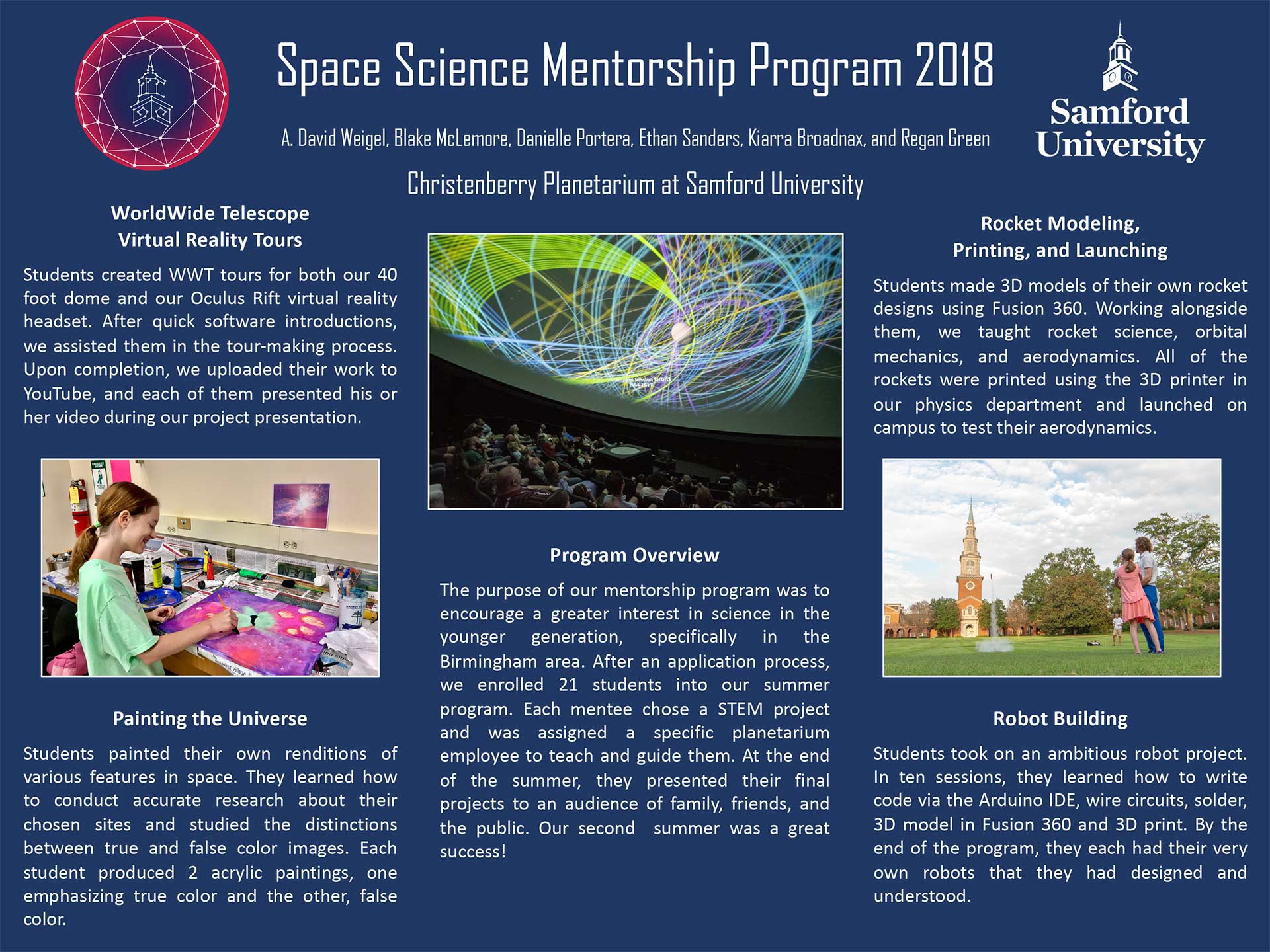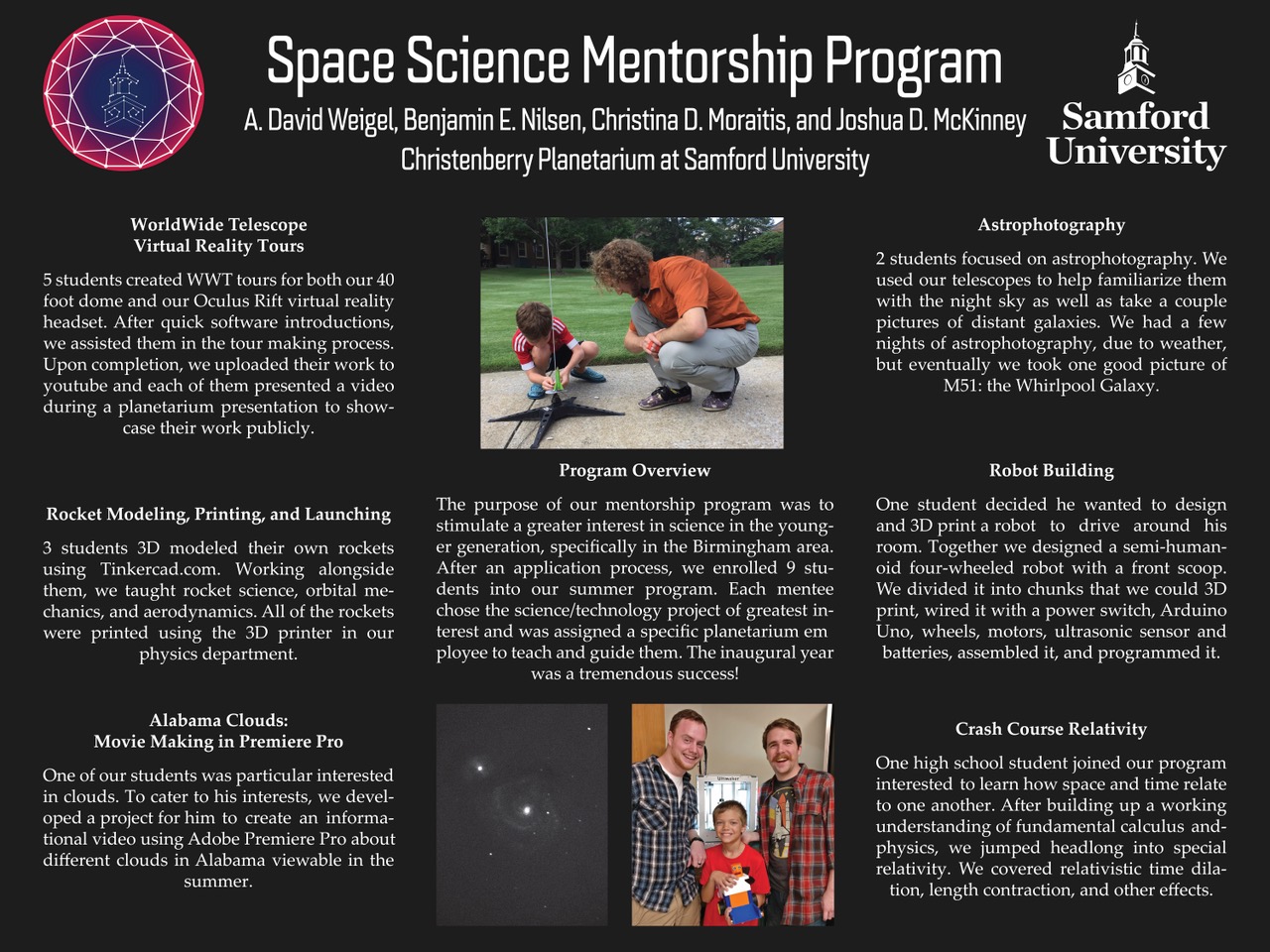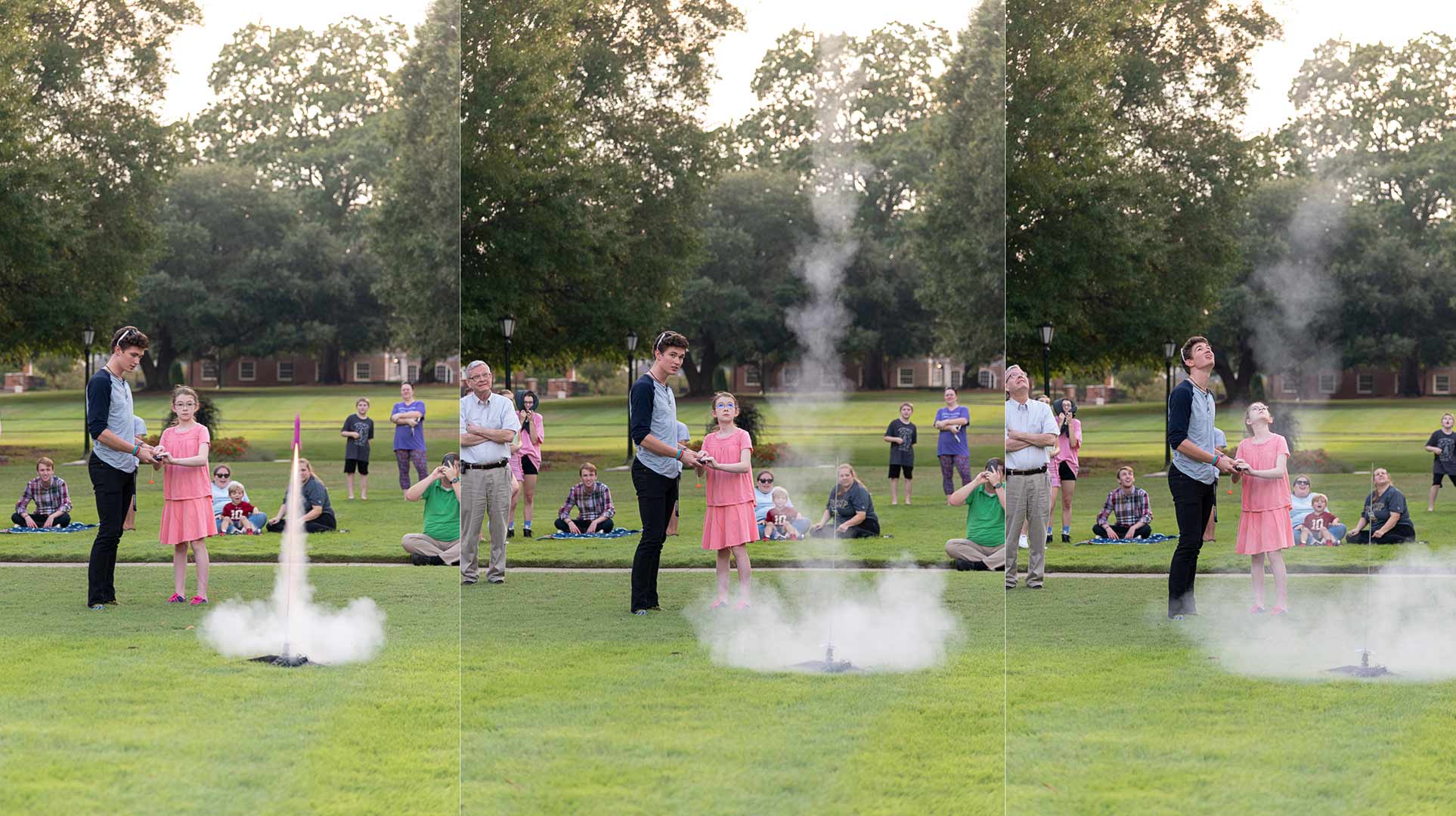Samford University’s Christenberry Planetarium offers rising 5th grade students through high school seniors a summer program of one-on-one mentoring and research.
Selected applicants will get a behind-the-scenes look at planetarium research and operations, and choose one space related research project to develop through 10 flexible summer sessions with the guidance of planetarium staff. Projects will conclude with public presentations.
Projects Offered in 2018
Explore the Universe in Virtual Reality (and on the Dome)
Explore the universe through WorldWide Telescope (our planetarium software). Travel to the surface of worlds like Pluto or Mars, study the asteroid belt, or zoom deep into the night sky to investigate entire galaxies. Students will create their own video exploring a topic of their choosing. Throughout production, videos will be viewed on the Christenberry Planetarium’s state of the art dome and in the planetarium’s Oculus Rift Virtual Reality headset. Upon completion of the video, the student will export a standalone flat screen version for YouTube.
Timeline
- Session 1-3: Introduction to WorldWide Telescope (and choose a topic).
- Session 4-8: Video production in WorldWide Telescope.
- Session 9-10: Export and edit in Adobe Premiere Pro.
Skills to be Learned
- Knowledge of Astrophysics / Planetary Science / Astrobiology as pertains to selected topic
- Proficiency in WorldWide Telescope – planetarium software
- Data visualization
- Video production: storyboarding, script writing, video editing
- Virtual reality / dome content production
Finished Product
A polished tour of (a facet of) the universe in standalone video (YouTube/mp4)!
Design, 3D Print, and Launch Rockets
Design a rocket from scratch in 3D modelling software to be 3D printed and launched. Students will learn rocket science and 3D modelling in order to produce 3 separate rockets using our 3D printer. Each rocket will be a functioning model that we will test launch throughout the summer.
Timeline
- Session 1-2: Introduction to 3D modelling (model single stage rocket with no recovery).
- Session 3-4: Model single stage rocket with parachute recovery (print previous rocket and test launch).
- Session 6-10: Model 2 stage rocket with parachute recovery (test launch all three models).
Skills to be Learned
- Knowledge of rocket science and aerodynamics
- Proficiency in 3D modelling software – Tinkercad and/or Fusion 360
- Experience in 3D printing
Finished Product
Three 3D printed rockets: single stage without recovery, single stage with recovery, 2 stage with recovery!
Paint the Universe
Visualizing the universe is beautiful yet complex endeavor. Do you ever look at pictures from the Hubble Space Telescope in awe at the intricate, colorful details? These colors can represent more than simply the visible spectrum of light that you and I see every day and each picture is processed in a unique fashion to convey data in different means. The student will scour the universe, selecting a world / nebula / galaxy / something awesome of interest to paint in natural color – as it would be viewed up close in visible light. In a second painting, the student will select an associated data set to “enhance” the original image and assign colors to visually convey this data. This student will learn various data visualization techniques and learn how to manipulate colors to portray elevation, chemical composition, different wavelengths of light, and so on.
Timeline
- Session 1-2: Topic selection and perusal of associated datasets
- Session 3: Sketch selected image
- Session 4-6: True color painting
- Session 7: Sketch selected enhanced image
- Session 8-10: Enhanced color painting
Skills to be Learned
- Painting with acrylic paint
- Data Visualization
- Understanding the electromagnetic spectrum, chemical composition of selected object, etc
Finished Product
2 hand painted 16x12 canvases of (something awesome in space)!
Design, 3D Print, Build, Program a Robot
Don’t want to leave the comforts of Earth but still want to explore? Build a robot to explore for you! The student will outline desired robot functionality and design a working robot in 3D modelling software. Once modelled, the student will 3D print robot parts and assemble them together with any sensors, motors, etc. The electronics will be coordinated by an Arduino (a tiny computer), which the student will program to function according to desired results. The end result: a fully functioning robot. Autonomy and artificial intelligence sold separately.
Timeline
- Session 1: Determine desired functionality and sketch robot
- Session 2-6: 3D model robot
- Session 7-10: Print robots parts, assemble, program, troubleshoot.
Skills to be Learned
- Proficiency in 3D modelling software – Tinkercad and/or Fusion 360
- Experience in 3D printing
- Programming arduinos
- Robot engineering
Finished Product
A functional robot!
Building Alien Life Forms
Do aliens exist? We certainly don’t know… yet. If they do, what might they look like? Students will explore various worlds using WorldWide Telescope (our planetarium software) to determine what factors decide whether life can be sustained on a planet. Upon comparing otherworldly environments with that of the earth, students will design and 3D model an “alien” that could theoretically survive in the selected environment. The alien(s) will be 3D printed.
Timeline
- Session 1: Explore the solar system, especially Mars and Titan (moon of Saturn). Compare various environments to that of the Earth.
- Session 2: Sketch an “alien” that could theoretically live on Mars using newly acquired knowledge of both conditions on Mars and biology. Introduction to 3D modelling software.
- Session 3: Explore extrasolar system habitable zone planets and compare their potential environments to that of the Earth.
- Session 4-8: Select world(s), 3D model alien(s) that could exist in the specified conditions, begin 3D printing parts.
- Session 9-10: Assemble models and create a presentation with data from the planet and specific features of the alien model which are adapted to those conditions.
Skills to be Learned
- Knowledge of Astrobiology / Astrophysics / (Exo)Planetary Science as pertains to selected topic
- Proficiency in WorldWide Telescope – planetarium software
- Proficiency in 3D modelling software – Tinkercad and/or Fusion 360
- Experience in 3D printing
Finished Product
3D printed alien(s)!
2018 Program Recap

2017 Program Recap


